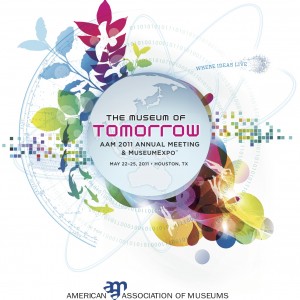 As the annual American Association of Museums Conference gets under way in Houston I thought it might be fun to riff off of their theme for this year’s conference: The Museum of Tomorrow. Having grown up in southern California, when I hear “tomorrow” I always think of Disneyland’s Tomorrowland and its promise of a different and better future.
As the annual American Association of Museums Conference gets under way in Houston I thought it might be fun to riff off of their theme for this year’s conference: The Museum of Tomorrow. Having grown up in southern California, when I hear “tomorrow” I always think of Disneyland’s Tomorrowland and its promise of a different and better future.
Hopefully in the visual and performing arts we are contributing every day to that new and better world through our programs, collections, events, and exhibitions. But what part does branding play in the future of the arts?
If we believe what we read we know that catching and holding someone’s attention will become increasingly difficult because if you think the market is noisy now with messages, it will become more so with endless advances in technology, even newer media, electronic gadgetry, and reach. That said, the arts are uniquely positioned to command attention. They provide the antidote to civilization, the opportunity to reflect, absorb, interact, or unplug.
So on a tactical level, what about arts branding in the future? Well, if you look at the two tools that branders have to play with: messages and visuals, there are ramifications for each.
For messages, we’ll need to hone our writing to deliver ever shorter, impactful, emotionally grabbing messages. In an increasingly distracted world, the need to move audiences to action will be more urgent . For example, a New York Times reporter recently said that one of the better ways to pitch a story now was through Twitter because of the sheer volume of information that reporters must now wade through. Wow, 140 characters to get across my sometimes complex message. There will also be a greater need to be able to scan-read a piece through headings, sub-headings, call-outs to decide if we want to read something in full. But the larger point is that we’ll need to pay even greater attention to the preciseness, brevity, and instant comprehension of our messages.
For visuals, it seems likely we will view them on smaller and smaller media. The increased emphasis on digital applications over print will certainly gain more momentum. How does the piece need to be layed out for onscreen? How does it look onscreen? Here too, simplicity, clarity, and telegraphic imagery will gain mounting importance. Graphic identities once initially designed for use on black & white print are now designed for use on small color screens, like a smart phone.
Finally, something less tangible, but no less achievable. A colleague of ours, Joan Cumming, touched on one aspect of working in the arts that’s relevant now and will increase in the future: fearlessness. In a speech she gave to Emerging Arts Leaders Los Angeles in October 2010, Joan talked about three characteristics for career and brand success:
1. Understanding your organization’s core values and core purpose: different from mission, the tenets of your organization and its reason for being, and matching your efforts to those values and purpose.
2. Searching for the truth: questioning and researching long-held assumptions about your organization including audiences’ likes and dislikes, and then not repeating the same actions in the hope of getting a new result.
3. Being fearless: the irony that the most creative field is sometimes lacking creativity in its marketing efforts, the fear of not wanting to waste sparse marketing dollars, having faith in your programs, and being courageous and stepping outside one’s safety zone to try new ideas. Joan also cautions to test ideas on a small-scale first. Use research as a baseline for assumptions and later as a metric of success.
It’s a worthwhile speech in its entirety of 38 minutes in three parts on YouTube, but if you only have 5 minutes, listen to the second half of Part 2.
To attain that promise of a different and better tomorrow through the arts, you may need to consider becoming fearless.

1 comment
Gengis Cohen says:
May 23, 2011
I think tomorrow is made up of the potential created today, with some unexpected tangential and entirely unexpected evolutionary events which might or might not occur in the overnight betwixt the two.
Speaking of fearless, it is probably about time real artists started being a little less fearful of the elephant in the room – curators, exhibitors, museum directors and the whole panoply of the Show and Tell machinery who are fundamentally superfluous without some decent art to show.
We have far too much audience pleasing and entirely too much entertainment dressed-up as art for anyone’s good.
Enjoy your conference by all means, celebrate the wonderfulness of your solipsistic academo-bolloqualisms but please, remain sufficiently and ever constantly mindful of that which is tail and that which is dog.
Museum commissions do nothing to help make important and world-changing art except for the kind of art-ertainment that those very museums and their rarified directorates think that audiences are likely to respond to – the sound of one hand missing itself is quite, quite deafening……….